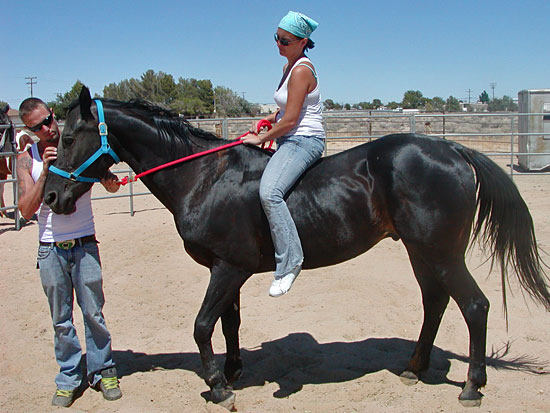
Seven months after being found wounded on the street, Trooper gets his first rider.
The 17-year-old gelding was in horrendous shape when sheriff’s deputies found him staggering along a rural residential street in the high desert city of Lancaster.
The malnourished, dark-chocolate brown horse had been shot six times. He had wounds on his forehead, neck, right shoulder and ribs. The deputies immediately summoned workers from the Los Angeles County Department of Animal Care and Control, who rushed him to the local animal care center and saved his life. They named him Trooper.
Several weeks later, as Trooper continued his recovery, George Rief walked through the shelter’s door. He’d been dropping by for years, looking for horses to adopt for a rescue operation he ran with his wife in neighboring Kern County. When he spotted Trooper, his heart sank. “He was in a real bad way,” Rief said. But that would soon change.
Trooper is an extreme example of a nation-wide surge in abandoned, abused and neglected horses that has put a strain on local shelters. Since 2008, L.A. County animal care employees have rescued an average of 125 horses per year—far above the usual numbers. Just this week, the Board of Supervisors voted to spend $350,000 for a 10-stall, open air horse barn in Agoura Hills, where there’s a strong market for horse adoptions. The barn will serve as a way station for malnourished, sick and injured horses while they recover and await adoption. It also will double as an evacuation facility in case of wildfires and other disasters.
Horses are expensive to keep, and that’s the problem. Food and basic care cost upwards of $2,000 per year, with boarding adding another $300 to $1,000 a month. When the recession hit, some owners couldn’t handle the outlay, said Marcia Mayeda, director of the county’s animal care and control department. Compounding the problem, demand at horse auctions dropped because of changes in federal laws and regulations that banned the slaughter of horses for meat. Previously, horse meat could be processed and shipped to countries like France and Belgium, where it is a traditional part of the diet.
“That dried up a place for owners to dispose of their horses—not that I’m in favor of that, but it contributed to why we’re now getting the horses,” Mayeda said.
The department accepts individual horses for a fee of $60 or $250, if the horse must be picked up.“There’s no need to abandon horses,” Mayeda said. “They can take them to a shelter and we’ll rehabilitate them and find them a home.”
The county finds homes for nearly all its horses, although some require behavioral training to make them suitable for adoption. In rare cases in which there’s an untreatable condition, animals are euthanized. However, even malnourished, sick or injured animals often make full recoveries and can become riding horses for new owners, said Mayeda, a horse owner herself. Older or less fit animals still find homes as “pasture pets.”
“Even if they are a little arthritic and can’t be ridden any more, people will adopt them to be companion horses for animals they already have at home,” Mayeda said. “Horses are herd animals; they don’t like to be alone.”
George Rief didn’t want that fate for Trooper.
When he showed up at the Lancaster shelter three years ago, he was breaking his wife’s rules. He’s not supposed to go there alone because of his soft spot for ailing horses. “It’s like Home Depot; I’m not allowed there myself, either,” George joked. But when he saw Trooper’s condition, he called wife Clarene and recounted the tragic story. She was happy he went.
The couple first became horse owners because of Clarene’s childhood love of the animals. What started as a hobby evolved into a small-scale rescue operation. Over a period of eight years, the couple adopted 11 horses from the Lancaster shelter.
“At any given time they’d have 10 horses down there—eight of them would be great and two of them were bags of bones,” George said. “So we’d get the two bags of bones and bring them home.”
Clarene continued to nurse Trooper’s wounds, as their veterinarian monitored his progress. A farrier went to work on his hooves, which had grown to twice the length they should have been because of neglect. After seven months of rehabilitation, Trooper was doing so well that he accepted a rider.
“Everything healed up nice,” George said. “He’s as gentle as a lamb and easygoing—loves to be around people.”
The Riefs kept Trooper for a year while they waited for the perfect family to adopt him. He was never for sale, George said, but it took time to find someone who met their unofficial test: “If I don’t like them, my wife don’t like them or the horse don’t like them, they don’t get the horse.”
Finally, last December, a woman seeking a companion horse for her mare passed the test. George Rief has visited Trooper a couple of times in his new home, where he loves to take baths and recently passed a veterinary exam with flying colors.
“He’s getting fat,” Rief said. “I think she’s overfeeding him but I don’t care. He’s just enjoying life.”
Posted 8/27/14






